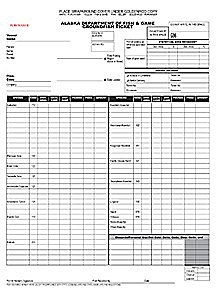Alaska Fish & Wildlife News
October 2006
Fish Tickets
Fishery Database is the Envy of the Industry

In the global fishery market, Alaska stands out as a giant. We have, arguably, one of the best managed fisheries in the world. Fish tickets play a large role in gathering the data that make this possible.
Fish tickets document the harvest of fish and shellfish sold, discarded, or retained by the fisherman for personal use. All licensed processors must fill out a fish ticket for each landing from a fishing permit holder. Fish tickets are a record of purchase between the processors (or buyers) and the fishermen, and for the resource managers, they are a record of the extraction of the resource – how many fish were taken from the sea. The information collected includes species landed, weight, gear used, harvest dates, who caught the fish, and the processor’s license code. Information specific to each fishery is also collected when the catch is delivered.
Fish tickets are printed and distributed by the Alaska Department of Fish and Game (ADF&G), Division of Commercial Fisheries. One copy of the ticket is sent to ADF&G, where it is checked, amended as needed, sorted, and the data entered.
Alaska’s fish ticket data goes back almost 40 years. Fish tickets may collect additional information over time, but seldom, if ever, are categories of information deleted. “We don’t want to compromise our legacy data,” said Gail Smith, Research Analyst with ADF&G. “Before we make a change, we ask ourselves ‘what does this do to our historic data?’ Our fish ticket data goes back to 1969. We are the envy of fisheries managers in other regions of the United States.”
Unfortunately, this historical data on paper, requires different people to enter the same information repeatedly. For years, there has been talk of electronic fish tickets -- consolidating state and federal fishery catch and landing information.

Fish tickets are confidential documents and require the signature of the permit holder and the buyer. The information, subject to confidentiality constraints as necessary, is used by fisheries managers, biologists, processors, fishermen and economists, and is available to various state and federal agencies.
This historic data is used for entitlement programs, economic analysis and biological management.
Processors operating in federal waters exclusively for federally-managed fisheries, such as groundfish, are not required to fill out ADF&G fish tickets -- although many do so voluntarily. Because of this, ADF&G has incomplete data sets for this fishery. “We get the full complement of data for salmon, herring and shellfish, but from groundfish – not so much,” said Smith.
Instead, production reports are submitted to the National Marine Fisheries Service, so there is some data available to ADF&G, but it is not the same data collected on fish tickets. “We have people here who have made a whole career out of extracting information out of the federal database and from the ADF&G fish ticket database to create a complete picture of the commercial harvest in the groundfish fisheries,” said Smith.
Both fish tickets and production reports are a summary of what was landed and discarded at sea, but production reports include what was produced from the fish landed.
The nine different types of ADF&G fish tickets are:
• General Salmon (A)
• Bristol Bay Salmon (B)
• Crab Shellfish (C)
• Groundfish (G)
• Herring (H)
• Miscellaneous Shellfish (M)
• Pacific Halibut (P)
• Shrimp (S)
• Tender – Salmon (T)
Subscribe to be notified about new issues
Receive a monthly notice about new issues and articles.
